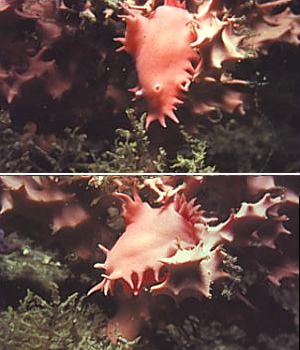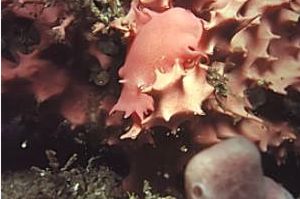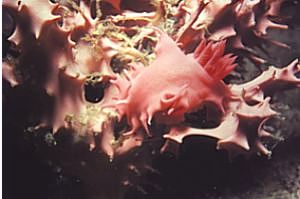Verconia verconis from Sydney
April 15, 2001
From: Akos Lumnitzer

Hi Bill,
A friend of ours told us he found Verconia verconis at Kurnell, entrance to Botany Bay in Sydney last weekend. With only two rocks as reference points between which to find the beast, I went hunting for it.
Now there were at least 100 boulders to scan over, but I managed to find the nudibranch. It is definitely a first for me in Sydney and also for our friend Noel Conlon, who had only seen the species in South Australia before.
Interestingly this species of sponge is renowned for sustaining small communities of Chromodoris tasmaniensis, of which there were several tiny juveniles on the sponge itself. I also saw an egg ribbon, but to which species it belonged to is a mystery. Could it be possible for the V. verconis to store eggs and lay them upon a suitable food source????
Anyway, here it is and I am looking forward to taking my wife Donata out for a peek very shortly. Anyway, we did think it was an unusual sort of a creature for Sydney - that ought to make the other nudie nuts jealous.
Regards
Akos
dna72@softhome.net


Dear Akos,
This is indeed a very unusual find. As far as I know this species has never been found anywhere in New South Wales before. It has been considered a southern temperate species found from Bass Strait across to south-western Australia. The sponge in your photos seems to be a species of Darwinella which is its typical food. It is also the food of Chromodoris tasmaniensis.
The importance of this find is not just that it is a geographical range extension of about 500 kilometers further north than it has been found before, but it is an extension beyond the Green Cape [Victoria / New South Wales] boundary which seems to represent a real zoogeographic boundary in southeastern Australia. It is an extension north against the direction of the prevailing water movements. I presume this is a natural range extension although I guess it is possible someone has transplanted it, or it has spread with shipping. I guess all we can do is see what happens and ask anyone diving in New South Wales to keep a look out for it.
If you get a chance, I would be interested in a photo of the juvenile C. tasmaniensis and the egg mass you mention. The eggs of C. tasmaniensis are quite large, so it might be possible to identify the egg ribbon. This is indeed an interestng find
Best wishes,
Bill Rudman
Related messages
-
Verconia verconis? from Western Australia
From: Wendy Hutchison, March 23, 2006 -
Verconia verconis from Jervis Bay, eastern Australia
From: Sue Newson, October 27, 2005 -
Egg-laying Verconia verconis
From: John Chuk, April 1, 2001 -
Pink nudibranch from Victoria, Australia
From: Terry Swanson, March 27, 2001 -
Variation in Verconia verconis
From: Stuart Hutchison, February 8, 2000 -
Juvenile Verconia? from South Australia
From: Stuart Hutchison, January 30, 2000 -
Orange Verconia verconis
From: Stuart Hutchison, January 28, 2000 -
Verconia verconis from southern Australia
From: Bill Rudman, August 30, 1999
